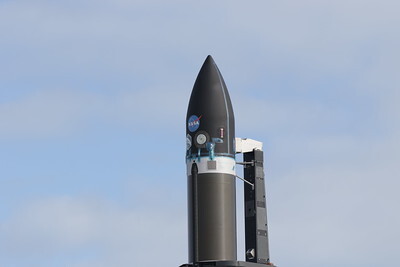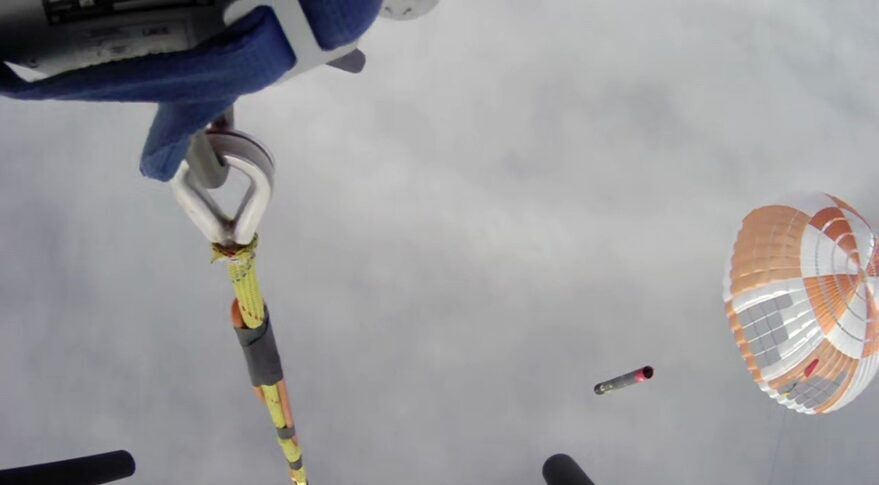3.11.2022

Rocket Lab USA, Inc. (Nasdaq: RKLB) (“Rocket Lab” or “the Company”), a leading launch and space systems company, today confirmed that it will attempt to catch an Electron rocket with a helicopter as it returns to Earth from space during the Company’s next launch.
“Our first helicopter catch only a few months ago proved we can do what we set out to do with Electron, and we’re eager to get the helicopter back out there and advance our rocket reusability even further by bringing back a dry stage for the first time.”
Tweet this
Rocket Lab’s 32nd Electron launch, the “Catch Me If You Can” mission, is scheduled to launch from Pad B at Rocket Lab Launch Complex 1 during a launch window opening on November 04, UTC. Electron will carry a science research satellite by space systems provider OHB Sweden for the Swedish National Space Agency (SNSA). The Mesospheric Airglow/Aerosol Tomography and Spectroscopy (MATS) satellite is the basis for the SNSA’s science mission to investigate atmospheric waves and better understand how the upper layer of Earth’s atmosphere interacts with wind and weather patterns closer to the ground. MATS was originally due to fly on a Russian launch service before the mission was manifested on Rocket Lab’s Electron.
“Catch Me If You Can” will see Rocket Lab attempt to capture the rocket’s first stage mid-air with a helicopter as it returns from space. Using a modified Sikorsky S-92 helicopter to catch and secure the rocket by its parachute line, Rocket Lab will bring the captured stage back to its Auckland Production Complex to be processed and assessed by engineers and technicians for possible re-use.
This Electron recovery effort follows the catch of an Electron first stage during Rocket Lab’s first helicopter recovery attempt on the “There And Back Again” launch in May, and the recovery attempt for this mission will follow the same concept of operations as the previous launch.
Rocket Lab CEO and founder, Peter Beck, says: “Our first helicopter catch only a few months ago proved we can do what we set out to do with Electron, and we’re eager to get the helicopter back out there and advance our rocket reusability even further by bringing back a dry stage for the first time.”
“Catch Me If You Can” launch details:
- Launch Window Opens: November 04, UTC
- Launch vehicle: Electron
- Customer: Swedish National Space Agency through OHB Sweden
- Launch site: Rocket Lab Launch Complex 1, Pad B
- Orbit: 585km circular Earth orbit
- Payload: MATS
Recovery Mission Profile:
- Shortly before lift-off, the customized Sikorsky S-92 recovery helicopter will deploy to the capture zone at sea, approximately 160 nautical miles off New Zealand’s Banks Peninsula.
- Once launched, Electron’s first and second stages will separate at approximately T+2:32 minutes into the mission. The MATS payload will continue to orbit onboard the rocket’s second stage while Electron’s first stage descends back to Earth. At this point in the mission, Electron’s return is expected to reach speeds of up to 8,300km (5,150 miles) per hour and temperatures of up to 2,400 degrees C (4,352 F).
- At approximately T+7:20 minutes after lift-off, Electron’s first parachute will deploy followed shortly after by the rocket’s main parachute. The double deployment of parachutes helps to slow the returning first stage to 0.4% of its top speed during descent: from 8,300km per hour to just 36km per hour.
- As Electron enters the capture zone, Rocket Lab’s recovery helicopter will match the rocket’s speed and descent from above, attempt to secure the trailing parachute engagement line to the helicopter via a hook at the end of a long line.
- Once captured and secured, Electron will be transported back to Rocket Lab’s Auckland Production Complex. There, technicians will receive and prepare the stage for inspection to assess its suitability for re-use.
+ About Rocket Lab
Founded in 2006, Rocket Lab is an end-to-end space company with an established track record of mission success. We deliver reliable launch services, satellite manufacture, spacecraft components, and on-orbit management solutions that make it faster, easier and more affordable to access space. Headquartered in Long Beach, California, Rocket Lab designs and manufactures the Electron small orbital launch vehicle, the Photon satellite platform and the Company is developing the large Neutron launch vehicle for constellation deployment. Since its first orbital launch in January 2018, Rocket Lab’s Electron launch vehicle has become the second most frequently launched U.S. rocket annually and has delivered 150+ satellites to orbit for private and public sector organizations, enabling operations in national security, scientific research, space debris mitigation, Earth observation, climate monitoring, and communications. Rocket Lab’s Photon spacecraft platform has been selected to support NASA missions to the Moon and Mars, as well as the first private commercial mission to Venus. Rocket Lab has three launch pads at two launch sites, including two launch pads at a private orbital launch site located in New Zealand and a second launch site in Virginia, USA which is expected to become operational in 2022.
Quelle: BUSINESS WIRE
+++
Rocket Lab to attempt booster recovery on upcoming Electron launch

Updated Nov. 3 to include OHB Sweden’s role on the satellite.
WASHINGTON — Rocket Lab says it will make a second mid-air recovery attempt of an Electron booster during the launch later this week of a Swedish scientific satellite.
Rocket Lab announced Nov. 1 plans for its next Electron launch, a mission it calls “Catch Me If You Can.” The launch is scheduled for Nov. 4 at 1:15 p.m. Eastern from the company’s Launch Complex 1 in New Zealand.
The launch will be the second attempt to recover the Electron’s first stage, descending under a parachute, using a helicopter. In the first attempt May 2, a hook hanging from the helicopter grabbed the parachute, but the pilot released it moments later after noticing what the company called “different load characteristics than what we’ve experienced in testing.” The stage instead splashed down and was recovered by a boat.
“Our first helicopter catch only a few months ago proved we can do what we set out to do with Electron, and we’re eager to get the helicopter back out there and advance our rocket reusability even further by bringing back a dry stage for the first time,” Peter Beck, chief executive of Rocket Lab, said in a statement about the upcoming launch.
Beck said in the months after the launch that the company had been doing additional training on the helicopter recovery itself, rather than changes to the rocket and its recovery systems. “We haven’t made any changes to the vehicle or any of the recovery systems,” he said in an interview in late June. “It’s purely down to getting the technique right and just all the mission operations that go into that.”
He had hinted for months that another recovery attempt would take place in the near future, including at the company’s Sept. 21 investor day event, when he said the next recovery attempt was “coming up soon.” The Nov. 1 announcement was the first notice of this launch, including both the payload and the recovery plans.
Mid-air recovery is a key part of Rocket Lab’s plans to be able to reuse boosters after the company concluded a propulsive landing, like SpaceX’s Falcon 9, was not feasible for a small rocket. Catching the booster before splashdown avoids issues with salt water intrusion.
Beck said at the investor day presentation that the work attempting to recover Electron is helping the company as it develops Neutron, its medium-class reusable launcher that will perform propulsive landings. “There is no way we could have taken on the Neutron project with as much speed and confidence as we are without doing this,” he said, referring to Electron recovery. “We learned so much on reentering Electrons and going through the process of reusability that, if we had just gone straight to Neutron as a reusable vehicle without learning all of those super tough lessons, it would’ve been ugly.”
The upcoming launch will carry a single satellite, called MATS, or Mesospheric Airglow/Aerosol Tomography and Spectroscopy. The satellite, funded by the Swedish National Space Agency and built by OHB Sweden with some components provided by AAC Clyde Space, will study waves in the upper atmosphere and how they affect weather and climate.
MATS was originally scheduled to fly as a rideshare on a Soyuz rocket but the Swedish government canceled those plans in response to Russia’s invasion of Ukraine. The spacecraft, weighing about 50 kilograms, will go into a dawn-dusk sun-synchronous orbit at an altitude of 585 kilometers.
Quelle: SN

